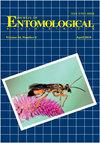降低微生物生物杀虫剂的使用率控制肉豆蔻(鞘翅目:肉豆蔻科)
IF 0.7
4区 农林科学
Q4 ENTOMOLOGY
引用次数: 0
摘要
山核桃象甲Curculio caryae(Horn)是山核桃的主要害虫(Harris 1985,第51-58页)。《山核桃象甲:研究视角》,W.W.Neel主编,鹌鹑岭出版社,布兰登,MS)。这些昆虫有2或3年的生命周期,大多数成年象甲从7月下旬到9月从树下的土壤中出现,以发育中的果实为食并产卵(Harris 1985)。四龄幼虫降落在地上,钻到8-25厘米的深度,形成土壤细胞,并越冬。在接下来的秋天,大约90%的幼虫化蛹,并在接下来的9个月里作为成虫在土壤中度过(Harris 1985)。剩下的种群(约10%)以幼虫的形式在土壤中度过约2年,第三年以成虫的形式出现。目前,对caryae的控制建议主要包括在树冠上使用化学杀虫剂(如西维因和某些拟除虫菊酯类)来抑制成虫(Acebes等人,2021,第5页,In Wells(编辑),《商业山核桃喷雾指南》。乔治亚大学扩展公牛分校。841)。尽管这些化学杀虫剂的应用在传统管理的果园中有效地控制了C.caryae,但在有机山核桃系统中缺乏关于C.caryaes管理的知识。此外,由于与蚜虫和螨死灰复燃相关的问题,这些问题通常是由针对C.caryae的化学杀虫剂应用引起的(Dutcher和Payne 1985,第39–50页,《Pecan Weevil:Research Perspective》,W.W.Neel(编辑),Quail Ridge Press,Brandon,MS),以及其他环境和监管问题,研究在有机系统和常规系统中开发替代控制策略是必要的。在之前的研究中,我们发现,在山核桃园中以每公顷3.36公斤的剂量施用微生物杀虫剂GrandevoT(基于枯草色杆菌Martin、Gundersen Rindal、Blackburn&Buyer),可以控制类似的caryae本文章由计算机程序翻译,如有差异,请以英文原文为准。
Control of Curculio caryae (Coleoptera: Curculionidae) with Reduced Rates of a Microbial Biopesticide
The pecan weevil, Curculio caryae (Horn), is a major pest of pecans (Harris 1985, Pp. 51–58. In Pecan Weevil: Research Perspective, W. W. Neel (ed.), Quail Ridge Press, Brandon, MS). These insects have a 2or 3-yr life cycle with most adult weevils emerging from soil beneath trees from late July through September to feed on and oviposit in the developing fruit (Harris 1985). Fourth instars drop to the ground and burrow to a depth of 8–25 cm, form a soil cell, and overwinter. During the following autumn, approximately 90% of larvae pupate and spend the next 9 mo in the soil as adults (Harris 1985). The remaining population (about 10%) spends approximately 2 yr in the soil as larvae and emerges as adults in the third year. Currently, control recommendations for C. caryae primarily consist of canopy applications of chemical insecticides (e.g., carbaryl and certain pyrethroids) to suppress adults (Acebes et al. 2021, Pg. 5, In Wells (ed.), Commercial Pecan Spray Guide. Univ. Georgia-Extension Bull. 841). Although these chemical insecticide applications are effective in controlling C. caryae in conventionally managed orchards, there is a lack of knowledge regarding C. caryae management in organic pecan systems. Additionally, due to problems associated with aphid and mite resurgence that often result from chemical insecticide applications that target C. caryae (Dutcher and Payne 1985, Pp. 39–50 In Pecan Weevil: Research Perspective, W. W. Neel (ed.), Quail Ridge Press, Brandon, MS), as well as other environmental and regulatory issues, research on developing alternative control strategies in both organic and conventional systems is necessary. In prior research, we discovered that that the microbial insecticide GrandevoT (based on Chromobacterium subtsugae Martin, Gundersen-Rindal, Blackburn & Buyer), applied in pecan orchards at 3.36 kg per ha, can control C. caryae at similar
求助全文
通过发布文献求助,成功后即可免费获取论文全文。
去求助
来源期刊
CiteScore
1.20
自引率
11.10%
发文量
40
审稿时长
>12 weeks
期刊介绍:
The Journal of Entomological Science (ISSN 0749-8004) is a peer-reviewed, scholarly journal that is published quarterly (January, April, July, and October) under the auspices of the Georgia Entomological Society in concert with Allen Press (Lawrence, Kansas). Manuscripts deemed acceptable for publication in the Journal report original research with insects and related arthropods or literature reviews offering foundations to innovative directions in entomological research

 求助内容:
求助内容: 应助结果提醒方式:
应助结果提醒方式:


